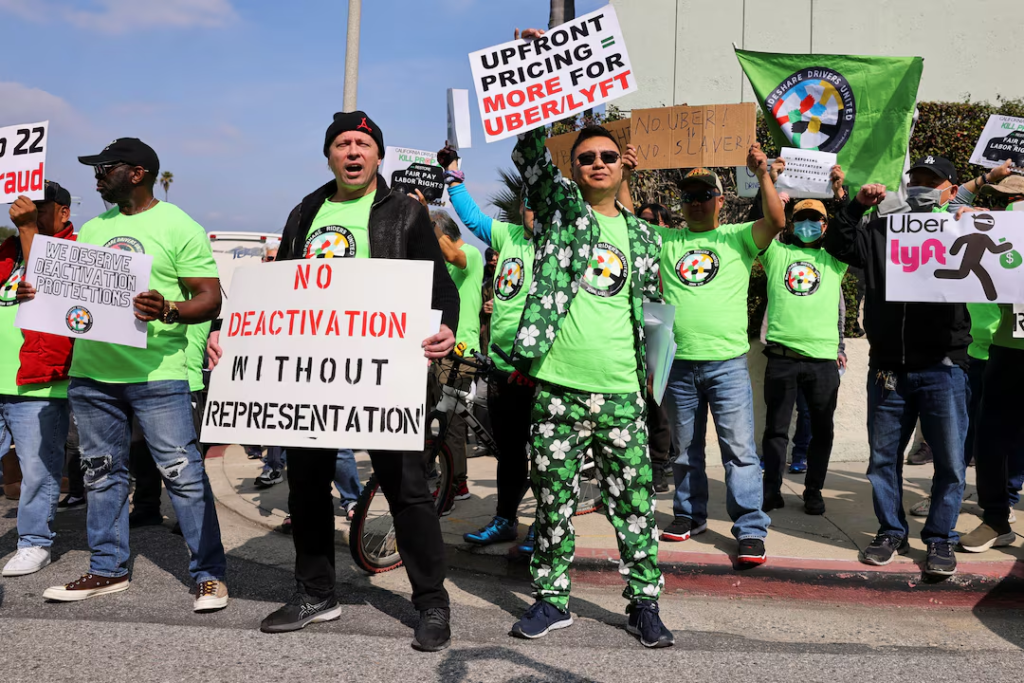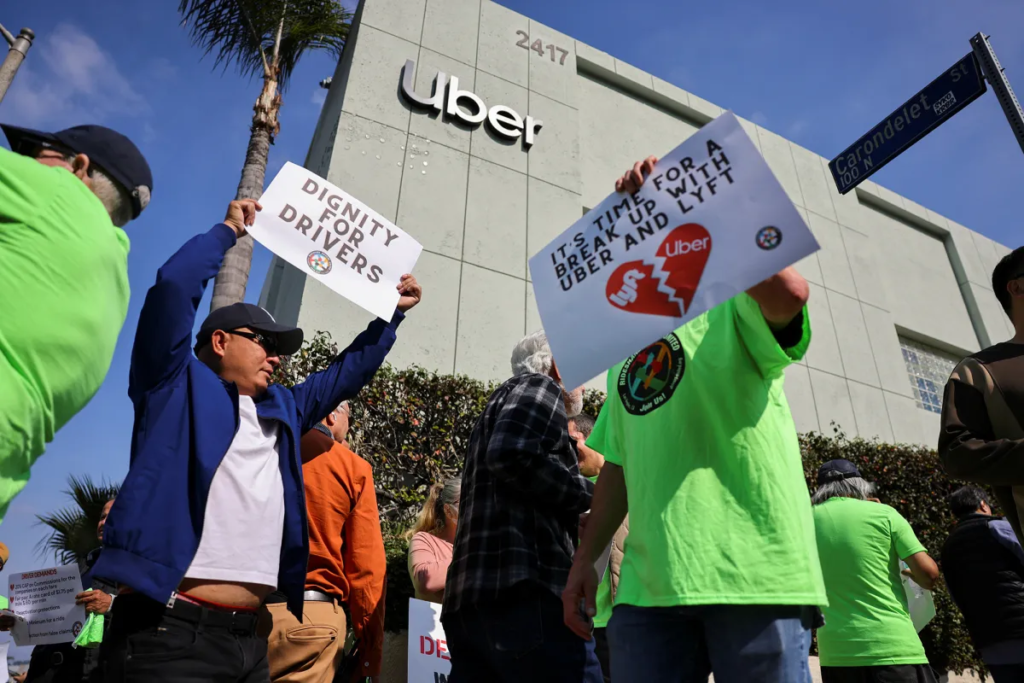Across the United States, gig workers are raising their voices, demanding better wages, improved working conditions, and stronger labor protections. From the bustling streets of Los Angeles to the busy airports of Chicago, drivers for ride-sharing giants like Uber and Lyft have organized strikes and protests to spotlight their struggles. These actions have sparked a nationwide conversation about the rights of gig workers and the future of the gig economy, an industry that employs millions but often leaves workers feeling undervalued and unprotected.
The gig economy, once hailed as a flexible and innovative way to work, is now at a crossroads. Companies like Uber, Lyft, DoorDash, and Instacart have built their business models on independent contractors, allowing them to avoid providing traditional employee benefits like health insurance, paid time off, or minimum wage guarantees. However, as the cost of living rises and gig workers face unpredictable pay, many are pushing back, calling for change through strikes, rallies, and advocacy for stronger labor laws. This growing movement is reshaping the way Americans view gig work and prompting questions about fairness, flexibility, and corporate responsibility.

The Heart of the Issue: Wages and Working Conditions
For many gig workers, the promise of flexibility—working when and where they want—was a major draw. Drivers like Alvaro Bolainez, who joined a protest at Los Angeles International Airport, initially saw ride-sharing as a way to earn a living on their own terms. But Bolainez and others say the reality is far less glamorous. “It’s like a rollercoaster,” Bolainez explained at a 2021 rally. “One week I can make $1,000, the next I’ll make $400 for the same hours.” Many drivers report earnings that sometimes dip below minimum wage after accounting for expenses like gas, car maintenance, and insurance.
The unpredictability of pay is a common grievance. Unlike traditional employees, gig workers don’t receive a steady paycheck. Instead, their income depends on factors like ride demand, surge pricing, and company algorithms that determine how much they earn per trip. These algorithms, often described as opaque, can change without warning, leaving workers with little control over their income. For example, some drivers have reported that Uber’s “Upfront Fares” model, which calculates pay based on individual driver behavior, feels like it penalizes them for factors beyond their control.
Beyond wages, gig workers face other challenges. They often pay out of pocket for vehicle repairs, fuel, and insurance, costs that can eat into their earnings. Deactivation policies, where companies abruptly remove workers from their platforms, also create insecurity. Drivers have reported being deactivated for minor or unproven reasons, such as customer complaints about not wearing a mask, leaving them without income or recourse. These issues have fueled frustration, pushing workers to organize and demand change.
Strikes and Protests: A Growing Movement
In recent years, gig workers have taken to the streets to make their voices heard. One of the largest strikes occurred on February 14, 2024, when thousands of Uber, Lyft, and DoorDash drivers in at least 44 cities refused to provide rides for several hours. Organized by groups like Rideshare Drivers United and Justice for App Workers, the strike highlighted demands for fair pay, transparency in how wages are calculated, and protections against unfair deactivations. Drivers gathered at major airports, chanting slogans like “We want fair wages, and we want them now!” to draw attention to their cause.
These protests aren’t new. In 2021, drivers across the country, from California to Maryland, staged similar actions, urging Congress to pass the Protect the Right to Organize (PRO) Act. This proposed legislation would allow gig workers to unionize and bargain collectively, a right currently denied to independent contractors under federal law. Although the PRO Act passed the House in 2021, it stalled in the Senate, leaving workers without the protections they sought. The failure of the PRO Act to move forward has only intensified calls for reform.
In California, the fight over gig worker rights has been particularly heated. In 2020, Uber, Lyft, and other gig companies spent over $200 million to pass Proposition 22, a ballot measure that cemented gig workers’ status as independent contractors. The measure promised benefits like healthcare subsidies and a minimum earnings guarantee, but many drivers say these promises have fallen short. At rallies, drivers have called Proposition 22 a “lie” and a “fraud,” arguing that it prioritizes corporate profits over worker well-being. A 2021 Reuters report estimated that Proposition 22 saved Uber and Lyft $392 million each in costs like payroll taxes and workers’ compensation, highlighting the financial stakes for these companies.

The Push for Employee Status
At the core of the labor rights debate is the question of whether gig workers should be classified as employees rather than independent contractors. Employees are entitled to protections like minimum wage, overtime pay, unemployment insurance, and the right to unionize—benefits that gig workers currently lack. In 2020, California’s Assembly Bill 5 (AB 5) aimed to reclassify many gig workers as employees, but Proposition 22 overturned its impact for ride-sharing and delivery drivers. Now, gig workers and labor advocates are fighting to roll back Proposition 22 and secure employee status.
The Biden administration has also weighed in. In 2021, Labor Secretary Marty Walsh signaled support for classifying gig workers as employees, a move that could increase costs for companies but provide workers with much-needed benefits. In 2024, the Department of Labor introduced a new rule to make it harder for companies to classify workers as independent contractors. While the rule doesn’t automatically reclassify gig workers, it could pave the way for future changes. However, companies like Uber and Lyft have pushed back, arguing that reclassification would undermine the flexibility that many drivers value.
Not all drivers agree on the solution. Some, like Jim Pyatt, a part-time driver in California, embrace the independent contractor model. “I treat it like a business and drive smart,” Pyatt said in 2021. “I never make less than $35 an hour, and I love the flexibility.” Others, however, argue that flexibility comes at too high a cost, leaving workers vulnerable to exploitation without a safety net.
The Bigger Picture: A Changing Labor Landscape
The fight for gig worker rights reflects broader concerns about the future of work in America. As the gig economy grows—projected to include 43 million workers by 2025—the issues of fair pay, benefits, and job security are becoming harder to ignore. Labor advocates argue that gig companies have created a “second-class” workforce, where workers bear the financial risks while companies reap the rewards. Veena Dubal, an employment law professor, has called California’s gig economy a “microcosm of a far bigger problem,” warning that the model could spread to other industries if left unchecked.

Unions and worker advocacy groups are stepping up their efforts. In California, the Service Employees International Union is backing a 2025 legislative proposal to grant gig workers collective bargaining rights. Meanwhile, lawsuits against Uber and Lyft over wage theft and misclassification are ongoing, with some drivers seeking billions in back pay for the pre-Proposition 22 era. These legal battles, combined with public protests, signal that gig workers are no longer willing to accept the status quo.
What’s Next for Gig Workers?
As the labor rights debate continues, the outcome will have far-reaching implications. For gig workers, securing better wages and benefits could mean greater financial stability and dignity in their work. For companies, reclassification or increased regulations could raise costs, potentially leading to higher prices for consumers. Policymakers face the challenge of balancing worker protections with the flexibility that many gig workers value.
The recent wave of strikes and protests shows that gig workers are determined to be heard. Their actions are not just about better pay but about redefining what it means to work in the gig economy. As Nicole Moore, a rally organizer, put it, “We’re fighting for a seat at the table.” Whether through legislation, lawsuits, or continued activism, gig workers are making it clear that they won’t stop until their demands for fairness and respect are met.
Know More :- Top 10 Best Education Trends in the USA You Need to Know in 2025






